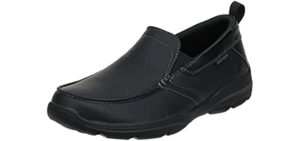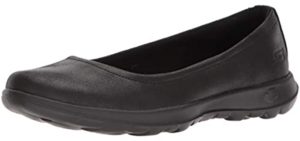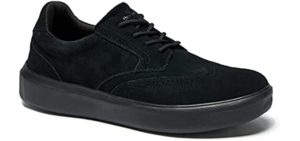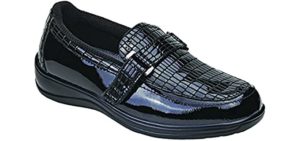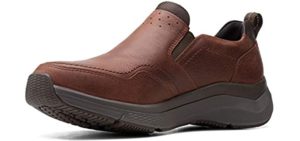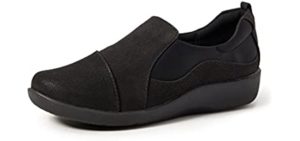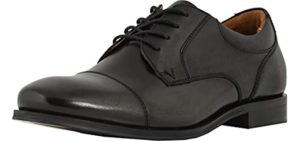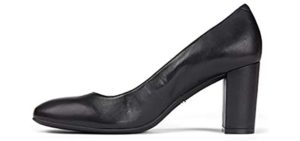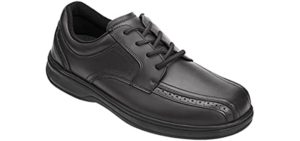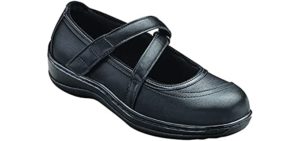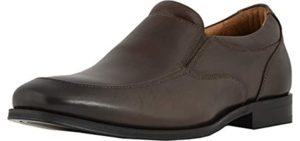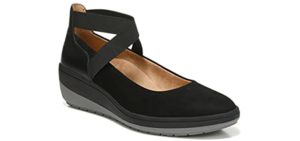Peroneal Tendonitis is an inflammation that may affect one or both of the Peroneal tendons that connect your lower legs to your feet; they are usually referred to as overuse injuries but may likewise be the result of a sudden injury such as an ankle sprain.
Peroneal Tendonitis can be treated and usually causes pain and swelling that lasts a couple of weeks.
The right shoes can help to prevent and help with the healing process of Peroneal Tendinitis. Most athletic shoes have many features to help with Peroneal Tendinitis, so you will have to look for similar features in dress shoes for Peroneal Tendinitis.
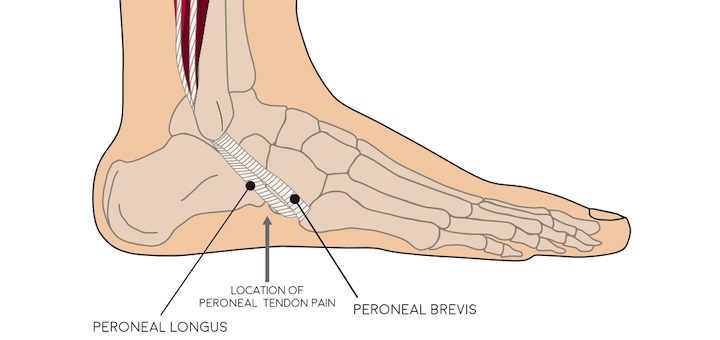
How Peroneal Tendonitis Affects You
You have tendons that run along the outside of your ankle bone and the side of your feet; these tough bands of tissues connect the muscles in your lower legs to the bones in your feet, called your Peroneal tendons. The Peroneal tendons help to stabilize and balance your feet and ankles to protect them from injuries such as ankle sprains.
When these Peroneal tendons become inflamed or damaged, it is called Peroneal Tendinitis. It is usually caused by overuse or sudden because of fall or injury to the foot or ankles.
Peroneal Tendinitis is more common in individuals that play sports involving plenty of ankle movements, such as tennis and basketball. However, anyone can get Peroneal Tendinitis. Peroneal Tendinitis, however, is not as common as Achilles Tendinitis and affects fewer people than Achilles Tendinitis.
- Causes – Peroneal Tendinitis can develop over time when the Peroneal tendons undergo repetitive strain and overuse, or you may suffer a foot or ankle injury that causes Peroneal Tendinitis.
- Symptoms – You may feel ankle pain along the length of the Peroneal tendon that will feel worse during exercise. There may likewise be swelling and redness or warmth around the tendons. In some cases, the tendons may thicken with repetitive irritation, and a mass or nodules may be found that move with your tendon.
- Complications – If left untreated Peroneal Tendinitis may end up in the Peroneal tendon rupturing when it partially or completely tears. In turn, a ruptured tendon can become weakened and damaged, leading to dislocation of the tendons. This causes ankle weakness, instability, and intense pain along the foot and ankles.
- Treatments – You can use conservative treatments to reduce pain in inflammation, such as resting, using ice, and using anti-inflammatory pain medication. Physical therapy is an option; an ankle brace can be worn to stabilize the ankles. Then again, proper footwear stabilizing your ankles can help prevent Peroneal Tendinitis and reduce movement to help with the healing process.
Shoes for Peroneal Tendinitis
When it comes to Peroneal Tendinitis, prevention is always better than cure, especially as you will find that improper footwear is one of the main causes of the condition.
You need to opt for footwear that provides plenty of ankle stability and support, especially running or walking. His stability helps to reduce pressure in your ankles and distributes impact equally over the entire foot.
Shock-absorbing cushioning in the midsole reduces the impact on your feet and ankles, and a cushioned insole helps soften your steps.
Softer and more breathable uppers materials with a comfortable fit and a secure heel will prevent your heel from slipping, which may affect your ankles. The shoe’s sole should likewise be more flexible to reduce the risk of an ankle injury.
Features of a Good Dress Shoe for Peroneal Tendonitis
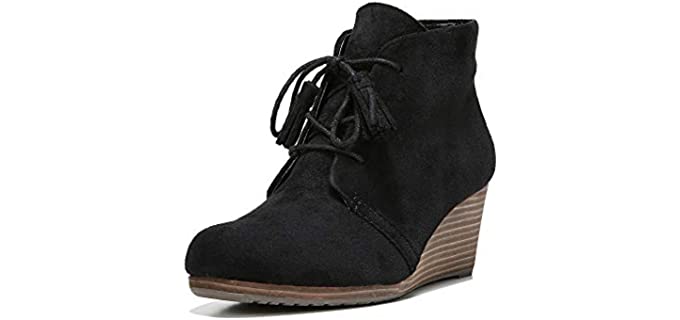
- High Heel-to-Toe Drop – Look for a dress shoe with a slight heel or at least a higher heel-to-toe drop that will prevent the ball of the foot from striking.
- Ample Cushioning – You need plenty of cushioning, especially in the midsole, to reduce the impact on your feet and a comfortable cushioned insole.
- Neutral Arch and High Arch Support – Peroneal Tendinitis is likewise more prone to affect individuals with high arch types. Higher arch support and neutral shoe models are advised for the condition itself.
- Flexibility – Choose shoes that are more flexible in the sole to allow for smoother heel-to-toe transitioning and prevent excessive ankle movements.
- Ankle Support – Look for dress shoes with a padded collar and a secure heel fit or longer length that protects your ankles and prevents excessive motion.
Reviews: The Best Dress Shoes for Peroneal Tendonitis
Below you will find some of the best available dress shoes for Peroneal Tendinitis;
1
Dress Shoe for Peroneal Tendonitis
- From Skechers, we have two more casual dress shoe models for use in the office and on less formal occasions.
- They offer a comfortable, roomy fit with ample cushioning and good arch support.
- The shoes have a lightweight feel and are an easy slip-on design.
- They have a durable and high-traction rubber outsole.
2
Dress Shoe for Peroneal Tendonitis
- Here we have two Orthopedic style shoes that are ideal for Peroneal Tendinitis.
- Because they offer better stability and proper arch support, they are ideal.
- The shoes have layered cushioning and a roomy toe box.
- They are formal in style, and you can use orthotics in them.
3
Dress Shoes for Peroneal Tendinitis
- The Sillian Paz has the perfect heel-to-toe drop and ankle support design for Peroneal Tendinitis.
- The shoes have flexible uppers and a cushioned OrthoLite Footbed.
- The Wave Edge is a slip-on dress shoe for men with leather uppers.
- The shoes have a cushioned and supportive footbed and a padded secure heel counter for ankle support.
4
Peroneal Tendinitis Dress Shoes
- From Vionic, we have an Oxford dresses shoe for men with a padded heel counter for ankle support.
- The ladies’ model is a medium-heeled dress pump with arch support and cushioning.
- The Oxford dress shoe has a cushioned footbed that is contoured for support.
- Both shoes have a durable rubber outsole.
5
Dress Shoe for Peroneal Tendinitis
- The Orthopedic dress shoe from Orthofeet is ideal because they have plenty of supportive cushioning and a deep-heel cup for ankle support.
- They are an extra depth and width designed to accommodate orthotics.
- The dress shoes are adjustable in fit and come in soft leather.
- They are likewise available in more colors and wider widths.
6
Peroneal Tendinitis Dress Shoe
- The Dress shoes from Vionic have a more flexible sole and comfortable soft leather and synthetic uppers.
- They feature Three-zone comfort and support, with a deeper heel cup, cushioning, and arch support for Peroneal Tendinitis.
- The outsole is a durable and high-traction rubber.
- The shoes are available in a few more color options.
Index Table: Top Rated Dress Shoes for Peroneal Tendinitis
| No. | Shoe | Men ♂ | Women ♀ | Features | Brand | Score |
|---|---|---|---|---|---|---|
| 1 | Skechers® - Dress Shoe for Peroneal Tendonitis | Harper | Go Walk Lite Ballet Flat |
| Skechers | 98.5 |
| 2 | OrthoComfoot® - Dress Shoe for Peroneal Tendonitis | Sneaker | Chelsea |
| OrthoComfoot | 98 |
| 3 | Clarks® - Dress Shoes for Peroneal Tendinitis | Wave Edge | Sillian Paz |
| Clarks | 97.8 |
| 4 | Vionic® - Peroneal Tendinitis Dress Shoes | Shane Oxford | Amor Mariana |
| Vionic | 97.5 |
| 5 | Orthofeet® - Dress Shoe for Peroneal Tendinitis | Celina | Gramercy |
| Orthofeet | 97 |
| 6 | Vionic® - Peroneal Tendinitis Dress Shoe | Sullivan Loafer | Advantage Ellery Wedge |
| Vionic | 97 |
Table of Contents
- How Peroneal Tendonitis Affects You
- Shoes for Peroneal Tendinitis
- Features of a Good Dress Shoe for Peroneal Tendonitis
- Reviews: The Best Dress Shoes for Peroneal Tendonitis
- Index Table: Top Rated Dress Shoes for Peroneal Tendinitis
